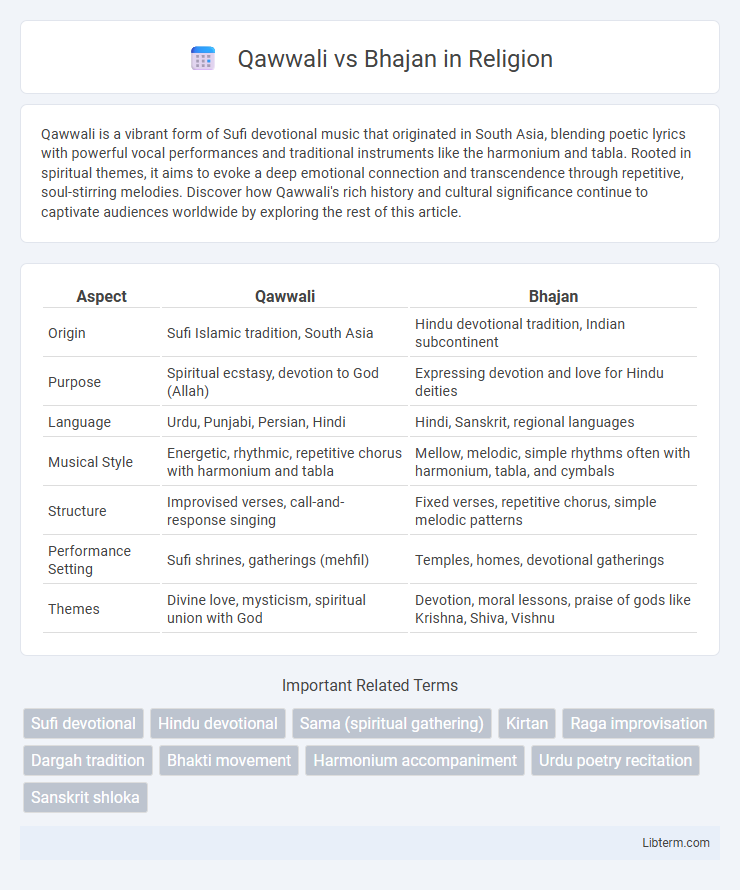Qawwali is a vibrant form of Sufi devotional music that originated in South Asia, blending poetic lyrics with powerful vocal performances and traditional instruments like the harmonium and tabla. Rooted in spiritual themes, it aims to evoke a deep emotional connection and transcendence through repetitive, soul-stirring melodies. Discover how Qawwali's rich history and cultural significance continue to captivate audiences worldwide by exploring the rest of this article.
Table of Comparison
| Aspect | Qawwali | Bhajan |
|---|---|---|
| Origin | Sufi Islamic tradition, South Asia | Hindu devotional tradition, Indian subcontinent |
| Purpose | Spiritual ecstasy, devotion to God (Allah) | Expressing devotion and love for Hindu deities |
| Language | Urdu, Punjabi, Persian, Hindi | Hindi, Sanskrit, regional languages |
| Musical Style | Energetic, rhythmic, repetitive chorus with harmonium and tabla | Mellow, melodic, simple rhythms often with harmonium, tabla, and cymbals |
| Structure | Improvised verses, call-and-response singing | Fixed verses, repetitive chorus, simple melodic patterns |
| Performance Setting | Sufi shrines, gatherings (mehfil) | Temples, homes, devotional gatherings |
| Themes | Divine love, mysticism, spiritual union with God | Devotion, moral lessons, praise of gods like Krishna, Shiva, Vishnu |
Introduction to Qawwali and Bhajan
Qawwali is a form of Sufi devotional music originating from the Indian subcontinent, characterized by powerful vocal delivery and rhythmic clapping designed to induce spiritual ecstasy. Bhajan, rooted in Hindu devotional traditions, emphasizes melodic simplicity and repetitive chants to foster a meditative and prayerful atmosphere. Both genres serve as expressions of deep religious devotion, yet Qawwali typically features dynamic ensemble performances, while Bhajan often involves solo or small group singing with minimal instrumentation.
Historical Origins and Evolution
Qawwali originated in the 13th century within the Sufi tradition of the Indian subcontinent, blending Persian, Arabic, and Indian musical styles to promote spiritual devotion through poetic lyrics and powerful vocals. Bhajan emerged from ancient Hindu devotional practices, evolving over centuries as a lyrical expression of bhakti (devotion) incorporating regional languages and folk melodies. Both genres have transformed with cultural exchanges and regional influences, maintaining their core spiritual essence while adapting to contemporary performances and audiences.
Key Musical Elements
Qawwali features powerful vocal improvisations, rhythmic clapping, and harmonium-driven melodies, emphasizing Sufi poetry and spiritual ecstasy. Bhajan centers on devotional lyrics supported by simple melodic structures, often accompanied by instruments like the tabla, harmonium, and cymbals to foster communal worship. Both genres utilize repetitive chants but differ in intensity and musical complexity, reflecting their distinct religious and cultural contexts.
Spiritual and Religious Significance
Qawwali and Bhajan both serve as powerful expressions of spiritual devotion within South Asian religious traditions, with Qawwali deeply rooted in Sufi Islam, emphasizing ecstatic praise and divine love through poetic lyrics and rhythmic musical patterns. Bhajans, integral to Hindu worship, focus on expressing devotion and surrender to deities like Krishna or Shiva, often characterized by repetitive chanting and simple melodies that facilitate meditation and communal prayer. Both forms transcend mere music, functioning as vehicles for spiritual connection, emotional release, and communal religious experience.
Language and Lyrical Content
Qawwali primarily features lyrics in Urdu, Punjabi, or Persian, emphasizing Sufi themes of divine love and mystical union with rich poetic imagery. Bhajan lyrics are predominantly in Hindi or regional Indian languages, focusing on devotional worship, praise of Hindu deities, and moral teachings conveyed through simple, repetitive verses. The linguistic style of Qawwali is more intricate and metaphorical, while Bhajan employs straightforward language aimed at communal participation and spiritual reflection.
Performance Styles and Settings
Qawwali performances feature energetic vocal improvisations and rhythmic clapping, often held in Sufi shrines or intimate gatherings, emphasizing spiritual ecstasy and collective participation. Bhajan sessions typically involve melodic chants and harmonium accompaniment, conducted in temples or homes to foster devotional meditation and communal worship. The dynamic, call-and-response style distinguishes Qawwali, while Bhajan emphasizes serene, repetitive prayers creating a tranquil atmosphere.
Instruments Used in Qawwali vs Bhajan
Qawwali predominantly features harmonium, tabla, dholak, and manjira, creating a vibrant and rhythmic soundscape essential to its Sufi devotional essence. Bhajan typically employs instruments like the ektara, dholak, manjira, and flute, contributing to its melodic and meditative atmosphere rooted in Hindu worship. The distinct instrumentation in Qawwali and Bhajan reflects their unique cultural and spiritual contexts, enhancing the overall devotional experience.
Notable Artists and Exponents
Qawwali features renowned artists such as Nusrat Fateh Ali Khan, Sabri Brothers, and Abida Parveen, who have significantly elevated the genre with their soulful and powerful renditions. Bhajan is prominently represented by artists like Anup Jalota, Lata Mangeshkar, and Jagjit Singh, known for their devotional and melodious contributions to Hindu religious music. Both genres reflect deep spiritual traditions, with Qawwali rooted in Sufi mysticism and Bhajan in Hindu devotional practices.
Global Influence and Popularity
Qawwali, rooted in Sufi devotional music, has gained global popularity through iconic performers like Nusrat Fateh Ali Khan, influencing world music and fusion genres. Bhajans, traditional Hindu devotional songs, maintain widespread appeal across India and among the Indian diaspora, often performed in spiritual gatherings and cultural festivals worldwide. Both genres showcase rich spiritual heritage but differ in their global reach, with Qawwali achieving broader international recognition through cross-cultural collaborations.
Modern Adaptations and Trends
Modern adaptations of Qawwali integrate contemporary instruments and fusion genres, attracting younger audiences while preserving traditional Sufi poetry and themes. Bhajan trends emphasize melodic variations and digital production, blending devotional lyrics with modern soundscapes for broader appeal. Both genres leverage social media platforms to expand their reach globally, reflecting evolving musical landscapes and cultural exchanges.
Qawwali Infographic

 libterm.com
libterm.com